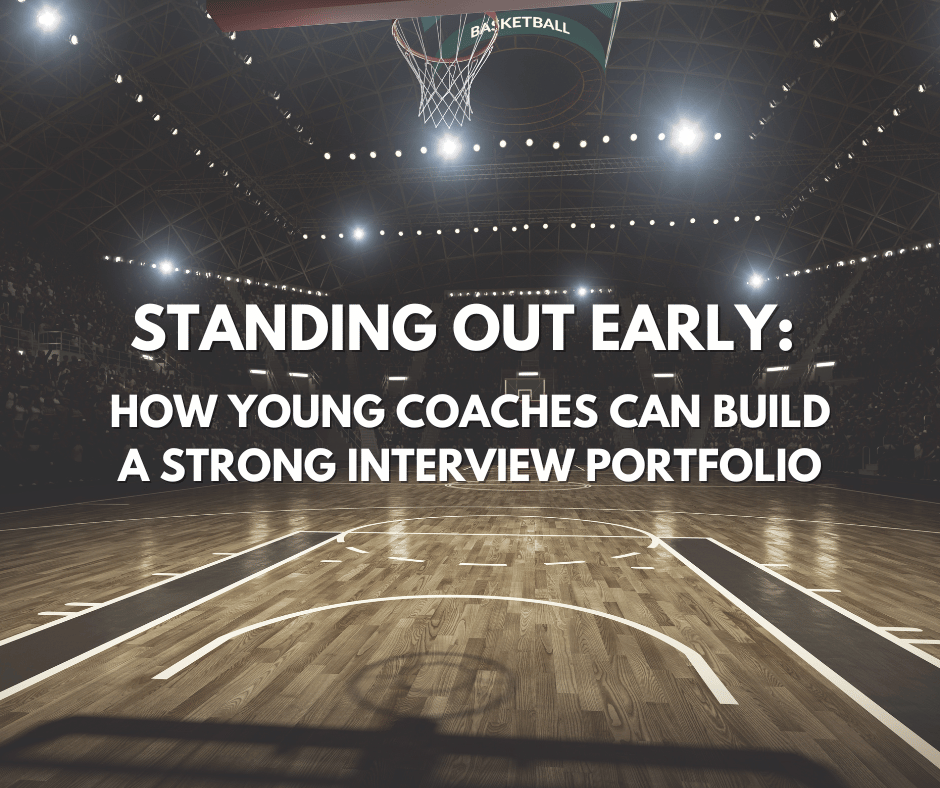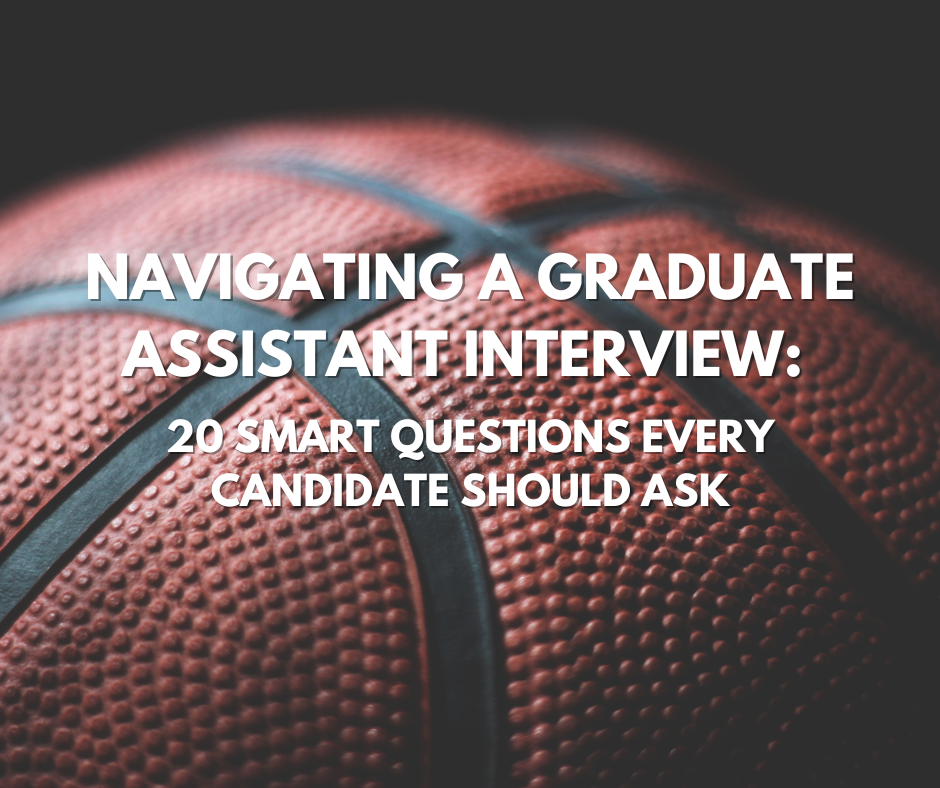This is a busy time of year for high school and college coaches who are going through the process of applying for a new coaching position. The job search process can be a stressful time filled with anxiety and rejection. Addressing deficiencies in your resume, portfolio, and interviewing skills can help you be more successful in landing a new position. Since creating my website, The Coaching Portfolio Guide, I’ve gotten a lot of questions from coaches about how to better succeed in the job search process. Below are some of the most common concerns I address with coaches who are seeking a new coaching position.
RESUMES
The biggest red flag to a hiring director when looking at your resume is when you have omitted your accomplishments or achievements in each of the places that you’ve worked. Most AD’s and head coaches will put your resume in the “no” pile if they cannot tell how a program improved while you were in a previous position. Typically, coaches tend to list what position they held and then list some of their general duties and responsibilities. One of the best ways to separate yourself from other candidates is to create a detailed list of things that were achieved and improved upon while you were at each of your previous positions. It could be team accomplishments or individual player accomplishments or things in general that were improved throughout the program while you were there.
Examples of things you can include on your resume:
- Championships. If you did not win championships, show how the program improved over the time you were there. That progression could include winning percentage, wins in a period of time, postseason achievements, milestones that have not occurred in some time (first time since….)
- Team or athlete recognition or awards
- Statistical improvement – both team and individual athletes.
- Improvements in the performance of athletes in the classroom.
- Off field/court activities or programs that were initiated – community service, team building activities, character building programs, fundraising initiatives.
- Other items – developing feeder/youth programs, college recruitment of student-athletes, strength & conditioning program improvements, camps/clinics that you coordinated.
These are just ideas to get you started. It is important to document all of these things throughout the year so that you can add them to your resume.
Often times, coaches are working in programs that may not have a lot of success. So if the numbers are not great, demonstrate the the accomplishments without the #’s. For example, just state, “2018 – established school record for number of wins in a season.”
When you have been with weaker programs, find other ways to bolster your resume. Camps, clinics, networking with higher profile coaches. Start your own instructional academies or some other type of side business. Part of my success in landing jobs has just been knowing how to network and market myself. I created my own marketing brand because of the side businesses that I operate. People look at all of the things that I do and realize how active I am in the coaching profession. My first week at a new job, the AD was sending other coaches to me on how to set up a camp business and build team websites. Obviously that stood out during the hiring process.
Another common mistake that coaches make is having a resume that is way too long. Many coaches have had a lot of stops as they try to climb the professional ladder. I know how difficult it is to remove information that you feel may be pertinent. However, by the time someone reading your resume gets to the second page, they start to become disinterested. And if they see there are more than two pages, they generally will not go past the first page. You need to get it down to two pages max, even with references. I know how tough that is, I have the same problem….I hate leaving things off. Put your best info on the first page. Provide brief summaries of positions you held long ago on the second page. Only use your “go-to” references–ones that will highly recommend you or ones that are recognizable names. Any info that you eliminate from your resume can be added to your portfolio if you feel it is that important.
The biggest way to gain some some space is to eliminate information that is extremely redundant or provides no real value to the person reading your resume, such as objective statements or professional summaries. Another way to reduce the length of your resume is to improve and simplify the layout and format. Very generic layouts and giant paragraphs make it extremely difficult for the reader to get through. Look for creative ways to utilize the entire space of each page. My favorite space-saving tip is to utilize a two column resume. You will get free resume templates when you sign up to become a member at the The Coaching Portfolio Guide!
PORTFOLIOS
Most coaches spend a lot of time talking about standards, expectations, goals, character development, and team-building. Those are concepts that are important to us. Therefore, we tend to spend a lot of time discussing those concepts in our portfolios. While those things should be included, they can often become boring, typical, and redundant. It’s all great stuff, but I would try to narrow down some of it to the most important stuff, things that will really jump out to the hiring committee. Put a twist on something….how is your stuff different from what other coaches are doing? Or present it in a different or unique way. I build my portfolio in Canva so that I can utilize more images or graphical presentations. It really makes things stand out. Again, the layout of your portfolio can really help present your information in a much more dynamic and interesting manner.
INTERVIEWS
Interviewing is difficult. I have a list of the most common questions I will face prepared in advance (you will get a complete list of the most common questions in a coaching interview when you sign up for the portfolio guide). I practice answering those questions over and over before an interview. I practice in my head, out loud to myself, I write down my answers in bullet points, and I have others ask me the questions so that I can practice with a real person. Couple of tips I really like….keep your answers short and concise. I tend to ramble which clouds my main points. And always have a list of questions you can ask throughout the interview. This shows that you came prepared and did your research.
FINAL THOUGHTS
So here are some thoughts when you say you are not getting the high profile jobs…..
Are you getting interviews? If not, why not? Is it a result of presentation of material or your actual experience. In terms of presentation, do you send out both a teaching resume and the coaching resume? If so, that is way too much.
The positions you are applying for…..are they positions you are qualified for? Are they positions you are trying to gain for teaching, coaching, both? What is the school’s hiring priority?
If you are getting interviews, is there an issue with your interviewing skills?
Part of the process is to continually evaluate how you are handling the process and where improvements could be made. A couple of years ago, I applied for jobs for the first time in 4 years. I got a LOT of rejection letters, but I also got a lot of interest…..calls, phone interviews, video interviews. I just couldn’t seal the deal. I kept making improvements in my resume, cover letter, portfolio, and interviewing skills based on how things were going. I asked for feedback from those I interviewed with to see how I could improve. I recommend you do that as well. That is where you will get your best feedback.
The number one thing I heard was that I needed to demonstrate to the hiring committee through my portfolio and especially my interviews that this job was the only job I was interested in and show them how interested I was in it. So the portfolio really needs to be tailored to each position you are applying for. It’s tedious and laborious, but it’s the only way to really to stand out. And your answers to interview questions really need to be targeted to what the hiring committee is looking for. You have to do a lot of investigative work prior to an interview to try and figure this out. You can also ask questions during an interview to learn more about what they are looking for and then focus on addressing those things.
I demonstrated my interest to the committee in the following ways:
- Researched every little aspect of the school, program, and community
- Tailored the portfolio to that specific job
- Prepared my interview answers with info that I had learned during my research
- Asked pertinent questions, again, based on your research
- Displayed energy and enthusiasm when speaking to anyone involved in the search process or anyone you may may while on campus
- When I applied for a new job I always followed up with an introductory email to the AD or head of the search committee. I included copies of my resume and a link to my coaching portfolio website.
Hope this helps if you are planning to apply for a new position. Let me know if you have questions!
Bill Vasko – Coaching Portfolio Guide






